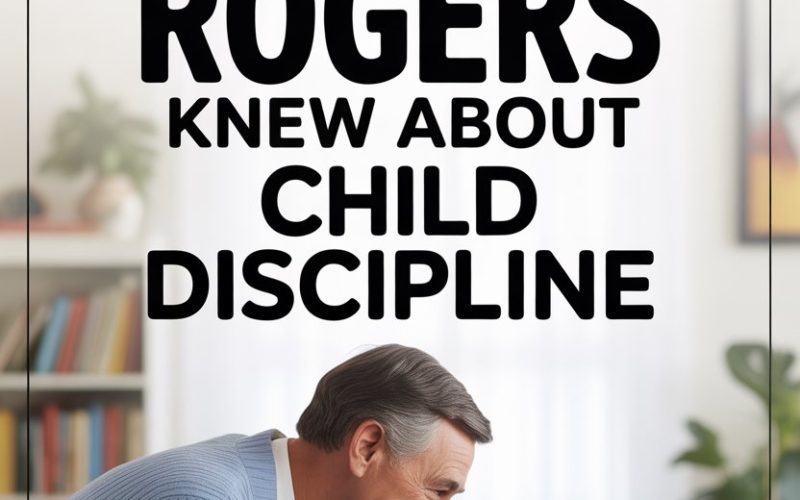Mister Rogers never needed a timeout chair or a sticker chart. Yet, somehow, generations of children sat utterly rapt, voices lowered, shoes swapped, and hearts opened.
Was there something in that signature cardigan that made him magic? Or did he simply know something about children—and discipline—that most of us missed between the after-school snacks and the bedtime standoffs?
While the rest of us were busy Googling “consequences for a four-year-old who bit his brother again,” Mister Rogers quietly offered a template for child discipline that works, even when the Wi-Fi doesn’t.
Discipline Begins with Unconditional Regard
Mister Rogers didn’t wait for children to earn his respect. He started every conversation from a place of genuine acceptance. That’s not just warm and fuzzy—it’s strategic.
Research consistently shows that children who feel valued and secure are far more likely to accept guidance. When kids know they’re loved no matter what, they’re less defensive and more open to learning how to behave.
Rogers made respect the starting line, not the finish line. Imagine how different discipline feels when your child knows they don’t have to “win” your approval to get a hug or to be heard.
If you want to borrow a page from his playbook, tell your child you love them at their worst moments, not just their best.
Say it when they’re melting down in the cereal aisle. Say it when the paint goes on the wall instead of the paper.
It’s not about excusing the behavior. It’s about anchoring your discipline in a relationship that can weather any storm.
Gentle Is Not Weak
Don’t mistake “gentle” for “pushover.” Mister Rogers carried a quiet authority, and children responded.
Much like a lighthouse in a storm, he stayed steady, calm, and clear on his expectations. Modern research backs this tone: kids need boundaries that are firm yet kind.
Setting these boundaries with a calm voice and soft eyes signals safety, not threat. Yelling may get short-term compliance, but it also teaches kids to tune out or double-down.
Try swapping volume for presence.
Kneel down. Look your child in the eye. Offer a limit with warmth: “It’s okay to feel angry. It’s not okay to hit.” Then, hold that limit with all the quiet confidence of a cardigan-wearing legend.
Honesty Builds Trust and Teaches Self-Control
Mister Rogers never lied to children—not about their feelings, not about mistakes, not even about death or divorce. He respected their intelligence and emotional depth.
Children can sense when adults are skirting the truth or sugar-coating the rules. If you’re not consistent with your own promises (“Five more minutes” shouldn’t secretly mean “Until I finish this email”), they’ll learn to push back.
Rogers modelled honesty, even when topics were tough or awkward. He demonstrated that discipline doesn’t mean hiding reality or pretending everything is perfect.
If you’re struggling to stick to a boundary, name it: “I know I said we’d leave the park after one more slide, but I’m finding it hard because you’re having so much fun. Still, it’s time to go.”
This builds trust and shows your child that even grown-ups wrestle with self-control—and keep trying.
Feelings Aren’t the Enemy
The man sang about “the mad that you feel” and spent episodes naming emotions that grown-ups (ahem) still have trouble admitting.
Mister Rogers understood that discipline isn’t about suppressing feelings; it’s about helping children handle them. Tantrums, tears, and outbursts aren’t misbehavior—they’re messy attempts to cope with overwhelming emotions.
Rogers invited kids to recognize their feelings, not run from them.
Try narrating what you see: “It seems like you’re really frustrated that it’s time for bed.” You’re giving your child language for their inner world.
Naming emotions with empathy doesn’t mean you’re letting them call the shots. You’re simply giving them the emotional toolkit to choose better actions next time.
Limit the Lectures, Welcome the Questions
Ever notice how Mister Rogers never launched into a ten-minute rant about “making good choices”? Instead, he asked questions and waited.
Sometimes, he just let the silence stretch—a strategy designed to invite children into the conversation.
Discipline works better as a two-way street. Instead of preaching, invite your child’s perspective: “What do you think would help you remember to hang up your coat?”
This collaborative approach boosts problem-solving skills and helps kids take ownership of their behavior.
Save the PowerPoint presentations on “Why Siblings Shouldn’t Be Used as Ladders.” Ask, listen, and watch as your child surprises you with insight.
Routines Are a Love Language
Cardigans, fish tanks, feeding the fish—Mister Rogers’ world ran on predictability. Children crave structure not because they’re future accountants, but because routines help them feel safe.
Consistent routines cut down on battles and make discipline easier. When kids know what to expect, their brains waste less energy on worry and more on learning.
Even research on bedtime routines shows benefits for everything from sleep to emotional regulation.
Consider how many “discipline issues” happen when kids are hungry, tired, or suddenly yanked from one activity to the next.
Transition warnings (“Five minutes until we clean up”) and rituals (singing a tidy-up song, a bedtime story) can work magic—no puppets or trolley required.
Apologies Are a Superpower
Did Mister Rogers ever get snippy? Probably, though we never saw it on camera. What we did see: a grown man admitting when he made mistakes.
Children need to see adults model genuine apologies—without the “but you made me” addendum. The art of saying, “I’m sorry, I lost my temper,” teaches humility and accountability. It also opens the door for kids to do the same.
If emotions run high and you slip up, circle back and own it. Your child will learn that making mistakes doesn’t sever a relationship.
In fact, repairing after conflict is one of the most powerful discipline tools around.
Consequences with Compassion
Mister Rogers didn’t believe in punitive punishment. He understood the difference between discipline (teaching) and punishment (hurting).
Logical consequences—ones that relate directly to the behavior—make sense to children and help them learn. If your child throws their dinner on the floor, the meal ends.
If they color on the walls, they help clean it up. Harsh punishments, on the other hand, teach kids to fear you or to get sneaky.
Approach consequences with empathy: “I see you’re upset about cleaning up. It’s not easy, but I know you can do it. I’ll help get started.”
Children who experience compassionate consequences learn not just what to do, but why it matters.
Notice the Good (Even When It’s Small)
Mister Rogers had an uncanny knack for seeing the good in everyone, especially children. He didn’t wait for grand achievements to offer praise—he noticed effort, kindness, and curiosity.
Research supports this approach: catching kids being good increases positive behavior far more than focusing on mistakes. If your child shares a toy, helps a sibling, or takes a deep breath instead of screaming, mention it.
Even a simple, “I saw you tried really hard to stay calm. That was brave,” goes a long way.
Children (and adults) flourish when they feel seen for more than their slip-ups.
Discipline That Lasts Longer Than a Lifetime
Mister Rogers’ secret wasn’t a discipline technique. It was a worldview: children are people, not problems to be solved.
They deserve patience, honesty, and respect, even when their behavior makes us want to move to the Land of Make-Believe ourselves.
Slowing down, listening, and leading with empathy sounds almost quaint in a world of sticker charts and viral parenting hacks.
Yet, the science keeps catching up with Mister Rogers’ wisdom: connection and gentle firmness grow resilient, kind, and responsible humans.
Next time your child is having a rough day (or you are), swap the lecture for a song. Offer a hug, a limit, and a listening ear. See what happens.
Sometimes, the magic isn’t in the cardigan. It’s in the way we choose to see—and respond to—the people right in front of us.
And if you need backup, remember what Mister Rogers said: “Anyone who does anything to help a child in his life is a hero.”
Cardigan or not, that means you.





